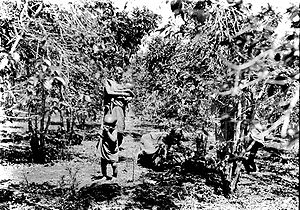- Coffee production in Kenya
-
The coffee industry of Kenya is noted for its cooperative system of production, processing, milling, marketing, and auctioning coffee. About 70% of Kenyan coffee is produced by small scale holders. It is estimated that six-million Kenyans are employed directly or indirectly in the coffee industry. The major coffee growing regions in Kenya are the High Plateaus around Mt. Kenya, the Aberdare Range, Kisii, Nyanza, Bungoma, Nakuru and Kericho. The high plateaus of Mount Kenya, plus the acidic soil provide excellent conditions for growing coffee plants. Coffee from Kenya is of the 'mild arabica' type and is well known for its intense flavor, full body, and pleasant aroma. Since 1989, production in this East African country fell from about 130,000 thousand metric tons to 50,000 tons in 2009.
Contents
History
Despite its proximity to Ethiopia (widely believed to be the region from which coffee originated), coffee was not cultivated in Kenya until 1893, when French Holy Ghost Fathers introduced coffee trees from Reunion Island. The mission farms near Nairobi, the capital city of Kenya, were used as the nucleus around which Kenyan coffee growing developed.
Screen Size
While it may be widely known as a type of Kenya coffee, Kenya AA is actually a classification of coffee grown in Kenya. All Kenyan coffee is graded after it is milled. Grades are assigned based on the screen size of the bean. Beans with a screen size of 17 or 18 (17/64 or 18/64 of an inch) are assigned the grade AA, generally the largest bean. While the large bean size is considered by many to be a sign of quality, it is important to note that it is only one of many factors in determining high quality coffee.
Kenya Coffee is traded once a week at the Nairobi Coffee Exchange. It is based at The Coffee Plaza, Exchange Lane which is off Haile Selassie Avenue.
The coffee is packed in single sisal bags of 60 kg, but the bids are made per 50 kg bag.
Below is a sample of average prices of coffee (per 60 kg bag) at the auction.
- AA - $153.90
- AB - $114.21
- C - $97.29
- PB - $120.00
- T - $83.79
- TT - $111.83
- UG1 -$91.50
- UG2 -$82.90
- UG3- $71.50[1]
Notable coffee estates, cooperatives and factories
- Gikanda Cooperative Society — Gichathaini, Kangocho and Ndaroini Factories (Mathira, Nyeri)
- Kirimiri (Thika)[2]
- Tekangu Cooperative Society — Tegu, Karogoto and Ngunguru Factories (Mathira, Nyeri)
- Thiriku Farmers Co-op Society (Thingingi Area, Nyeri)
See also
- Sasini Tea and Coffee
- C Dorman Limited
- Fanzin Coffee and Tea
References
- International Coffee Organization - Exports by Exporting Countries, [1]. Accessed on 14 June 2006.
- Overview of the Kenyan coffee industry, [2]. Accessed on 14 June 2006.
- Kenya coffee [3]
External links
currency = Kenyan shilling Economy Central Bank of Kenya · East African Community · History of Trade · Kenyan shilling · Nairobi Stock Exchange · Kenya Economic Stimulus ProgramSectors and industries: Categories:- Economy of Kenya
- Agriculture in Kenya
- Coffee production by country
Wikimedia Foundation. 2010.

